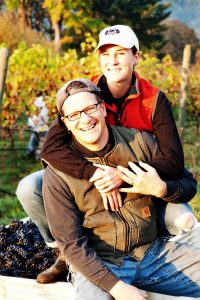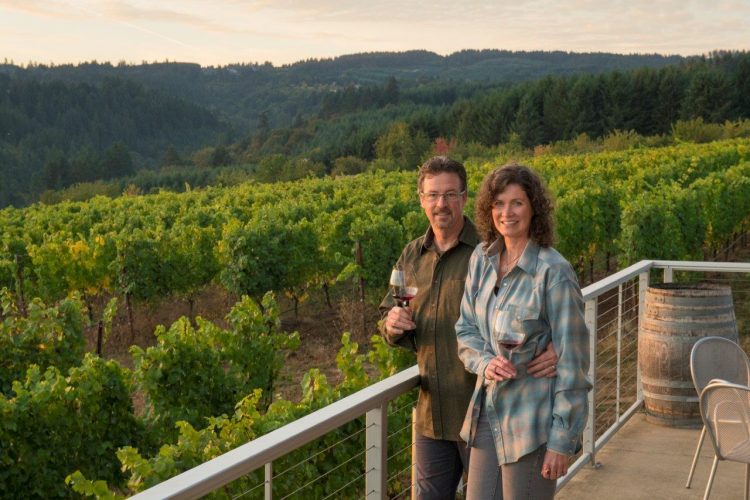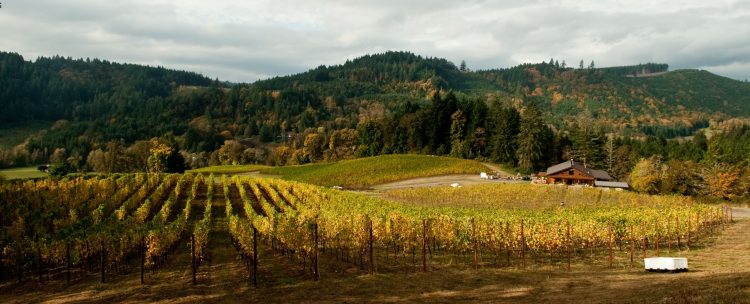When a small industry becomes wildly successfully very quickly, conventional wisdom will tell you that the relationship among the leaders of said industry will fracture.
On a recent trip out to Oregon for Willamette’s Pinot Noir Auction, I saw firsthand that the Oregon wine industry is contradicting that trend. Instead of competition, I saw cooperation.
While it’s tempting to romanticize their esprit de corps, in a way, the terroir itself demands it. The Valley has several sub-AVAs, all with different micro-climates and soil, shaped by winds, volcanic eruptions and ancient floods, yes. But it goes deeper than the soil.
Oregon is the ninth-largest state in the union, but with a population of about 4 million, it’s just the 27th most populous; about 60% of the state is covered in forest not inhabited by humans. The land itself is also geographically diverse, with volcanoes, dense evergreen and mixed forests, deserts, shrublands. It’s a mysterious place, where legends of Big Foot and a snake named Colossal Claude that would eat the Loch Ness Monster for lunch proliferate along with hipsters, flannel and artisanal everything.
It’s a relatively new U.S. state that has always marched to the tune of its own drum. Until the 1830s, it was almost entirely inhabited by native populations. Slowly, Oregon Trailers, missionaries and entrepreneurs began settling there, has continued to this day to be sparsely populated with a frontier paradigm. Oregon prides itself (and also depends for its survival) upon a spirit of cooperation among its inhabitants.
After touching down in Portland and driving out to the Willamette Valley, I saw first-hand how agriculture, hydroelectric power and the timber industry dominate the state’s economy. As does rain. In the 1960s, when three refugees of UC Davis—David Lett, Charles Coury and Dick Erath—headed up to Oregon to grow cool-climate varietals in the Willamette Valley, their cohorts thought they were insane; who would leave sunny California, with its sunny, predictable growing season for the water-logged chaos of Oregon?
Long, cool, wet winters and warm, (mostly) dry summers have, while throwing up plenty of challenges. Just ask any Willamette Valley winemaker what it’s like to harvest grapes in the rain; they all have horror stories. But the wines here have garnered more than their share of critical praise. For the past 12 months, Oregon has had 371 wines reviewed by Wine Spectator, 253 of which were rated 90 or above, a rate of 68%, compared with Washington, with 174 reviewed, 61 of which were rate 90 or above, a rate of 35%, or California, with 1,457 reviewed, 797 of which were rated 90 or above, a rate of 54%.
So how do winemakers scattered across such a gorgeous but demanding and unpredictable landscape manage to tease flavor out of the world’s fussiest and tough-to-grow grape, Pinot Noir?
When I spoke with leaders of the Oregon Wine Board and the Willamette Valley Wineries Association it became clear that a spirit of teamwork was embedded in its DNA.
“We are committed as an industry to keeping our spirit of collaboration, no matter how successful we become,” Sally Murdoch, communications manager at the Oregon Wine Board, tells me. “We accomplish that through informal get-togethers, but also through official seminars sponsored by the Wine Board and the Willamette Valley Wineries Association. Every year, we do educational boot camps, where winemakers exchange data on weather and soil, and notes on which clones seemed to grow best where, and why.”
Two winemaking couples, Scott and Annie Shull of Newberg’s Raptor Ridge Winery and Scott and Lisa Neal of McMinnville’s Coeur de Terre Vineyard, exemplify this spirit of cooperation. But before I share their story, let’s take a quick look at the numbers to determine just how successful the wine industry is, and how far it’s come.
While many wine regions worldwide are experiencing essentially flat growth, Nielsen cash register data shows Oregon’s wineries grew 12.4% in 2018, compared to the industry average growth of 1.5%.
And this is, of course, from a relatively young wine region. Though the first grapes were planted in the Oregon Territory in 1847 by an Oregon Trail trekking horticulturalist named Henderson Luelling, the wine industry as we know it began to gear up when David Lett of Eyrie Vineyards (and his fellow UC Davis expats) started planting Pinot Noir grapes in 1966. By 1970, the state still just had five bonded wineries with about 35 vineyard acres in production. But by 2018, Oregon had 774 wines, second only to California. In the Willamette Valley alone, there are now 23,524 acres under vine.
Educational seminars, data exchange, critical accolades and skyrocketing sales are all well and good, excellent even. But how do these dry factoids translate on the ground? I sat down with members of two different winemaking couples, Annie Schull of Raptor Ridge and Scott Neal of Coeur de Terre, to find out.

- ANNIE SHULL: Scott [Shull] started Raptor Ridge in 1995, and when I met him he was just getting it off the ground. We met working in the tech industry in Portland, and I started coming up to help him with harvests and bottling. We became romantically involved and he very wisely invited me to come out for an entire harvest season. He said if we made it through that, we could make it through anything. A year later, we got married, on 8/8/98 on our property. At that point, we’d just met Lisa and Scott [Neal].
- SCOTT NEAL: Yes. Lisa and I were captured by the Willamette Valley Pinot Noir bug in the 1990s. I grew up on a farm in Minnesota and I missed that life.To be honest, we didn’t have kids or enough sense to know any better, so in 1998, we sold everything we had in Colorado and bought 50 acres out here in Oregon. But before we even got there, we’d met the Shulls. I’d been reaching out to everyone I could, to find an email address for someone out here, and Scott ended up replying with a dissertation on the beauty and promise of the region, and that clinched it.
- ANNIE SHULL: As soon as they moved here, we just started hanging out and helping each other. We actually helped them plant their first vineyard block. In the beginning, we were making the wine, but were sourcing grapes from other growers, and they helped us plant our first grapes after they helped get us the land we planted on. Lisa actually got us our vineyard land before it even went on the market. Through the process of finding their own vineyard, she became an expert in wine real estate, and learned of a vineyard for sale right near us. She called and told us to get over there; it was just a two-mile tractor ride from our home, so it was perfect. We made an offer the same day. With their help and the help of their foremen, we have 18 acres planted out of our 28.
- SCOTT NEAL: Annie and Scott [Shull] helped us with our first plantings too, and they are the only other winemakers we have ever given grapes too; they made a Coeur de Terre designate winein 2002-2004. (Since then, we have used all of our grapes ourselves.) I learned so much from Scott because he’d been making wine here since 1989 with other winemakers, and by himself at Raptor Ridge since 1995. I honestly didn’t know the first thing except what I’d read in books, so until 2003, we actually made our wine separately but together.
- ANNIE SHULL: We mirror each other in many ways. They were first to plant, and first to make their own 100% estate wines. We were first to make our own wine, and we still actually use a network of 14 growers pulled from across the Northern Willamette Valley and seven sub-AVAs. We mirror each other, and we mirror several other winemakers who work closely together. It’s so obvious to the trade and the public when they get here that our collaborative spirit is genuine.
- SCOTT NEAL: It’s true. It’s rare that winemakers will take the time to not only recommend other winemakers to visitors and people in the trade, but to take the trouble to introduce them to each other, give directions to other wineries. You can’t fake the passion we have for our own wine and our genuine love and appreciation of the other winemakers here.
- ANNIE SHULL: When a new winemaker arrives, we welcome them with open arms, invite them to join our collaborations and make it crystal-clear that the cut-throat competition you see in other places has to be left at the door. Our hope is keep our roots, our collaboration and our spirit for the next generation of winemakers coming up.
- SCOTT NEAL: We want it actually etched in stone. We are working on passing laws that will make it clear through stringent labeling and winemaking guidelines that carpet-bagging here isn’t welcome. If you come here to make wine, great. But you will be held to a certain standard when it comes to winemaking and also your approach to interacting with other winemakers and the public.

The carpet-bagging comment was a reference to the California company Copper Cane, which sparked concern among Oregon winemakers after marketing its made-in-California wines as from Oregon on the label. Senate Bill 111 in Oregon, which has passed the Senate and is being studied by the Joint Ways and Means Committee, would strengthen Oregon’s labeling laws.
In just its fourth year, Willamette’s Pinot Noir Auction managed to break the seven-figure barrier. Every penny of that will go back to the Willamette Valley Wineries Association, for marketing and advertising purposes, which means while you’ve been hearing a lot about Oregon wine, you’ll soon hear even more.
Flying back to New York from Portland, and gazing at the mountains, rivers, lakes and forest below, I knew I’d be back; not just because drinking stupendous expressions of unique terroir is best done in the very place its grown, but because it’s a place that feels outrageously progressive and old-fashioned in the best way, an increasing rarity in an era of globalized sameness. Until then, I’ll be taking virtual trips, one sip at a time.


